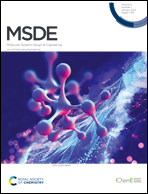(Si and B)-heterocyclic carbenes and theoretical design of new molecules†
Abstract
Using density functional theory (DFT), we theoretically designed fifteen novel and stable (Si and B)-heterocyclic carbenes (SiBHCs). While these SiBHCs are structurally similar to the B-heterocyclic carbenes (BHCs), their carbene character originates from the charge-shift (CS) bond of the inverted C![[double bond, length as m-dash]](https://www.rsc.org/images/entities/char_e001.gif) C bond. To demonstrate the applicability of these novel carbenes, we showed that they can bind with silver complexes to form (SiBHC)AgC
C bond. To demonstrate the applicability of these novel carbenes, we showed that they can bind with silver complexes to form (SiBHC)AgC![[triple bond, length as m-dash]](https://www.rsc.org/images/entities/char_e002.gif) CH, which are thermodynamically and electronically stable and contain a planar tetracoordinate carbon (ptC). Notably, SiBHCs can go through Diels–Alder reactions with butadiene, and the Diels–Alder reactions are feasible both thermodynamically and kinetically. Based on SiBHCs as C3 building blocks, we further designed three porous organic molecules (POMs) and one 2D covalent organic framework (COF). The three POMs (D1–D3) are situated at the minima on the potential energy surfaces and contain regular hexagonal channels. The POMs are extended into 2D structures with infinite lattices to produce a COF. The optimized lattice parameters of such a COF (COF-SiBHC-1) using an M06-2X functional under the periodic boundary condition (PBC) indicated that the COF is of hexagonal lattice. Thus, SiBHCs have potential applications in ptCs, organic chemistry and material design owing to their unusual geometrical and electronic structures.
CH, which are thermodynamically and electronically stable and contain a planar tetracoordinate carbon (ptC). Notably, SiBHCs can go through Diels–Alder reactions with butadiene, and the Diels–Alder reactions are feasible both thermodynamically and kinetically. Based on SiBHCs as C3 building blocks, we further designed three porous organic molecules (POMs) and one 2D covalent organic framework (COF). The three POMs (D1–D3) are situated at the minima on the potential energy surfaces and contain regular hexagonal channels. The POMs are extended into 2D structures with infinite lattices to produce a COF. The optimized lattice parameters of such a COF (COF-SiBHC-1) using an M06-2X functional under the periodic boundary condition (PBC) indicated that the COF is of hexagonal lattice. Thus, SiBHCs have potential applications in ptCs, organic chemistry and material design owing to their unusual geometrical and electronic structures.



 Please wait while we load your content...
Please wait while we load your content...